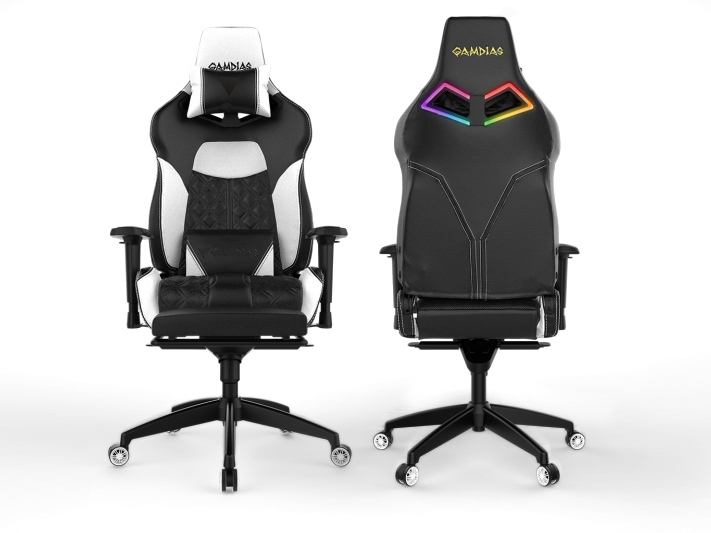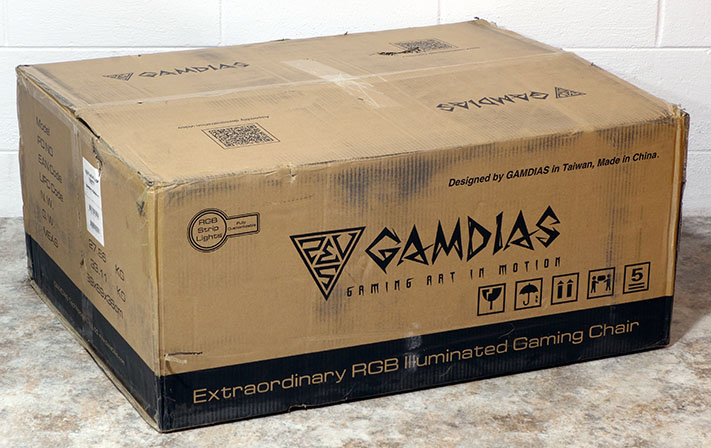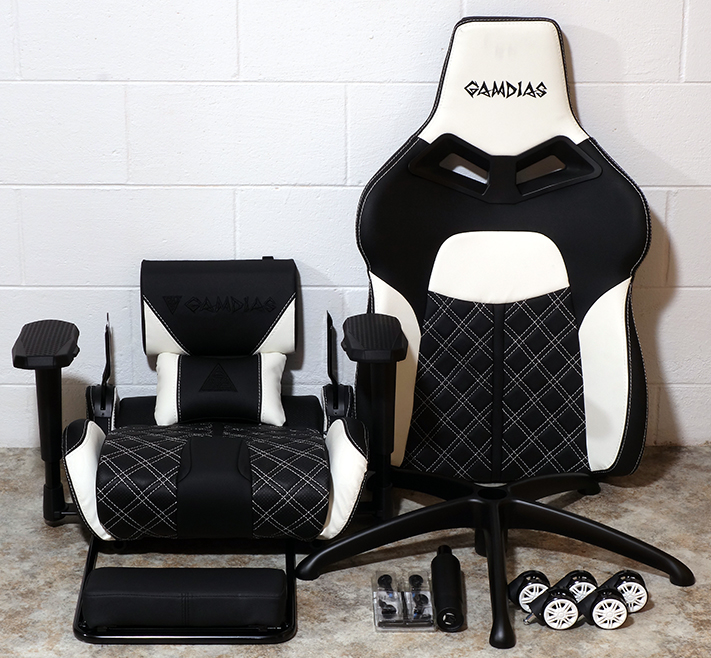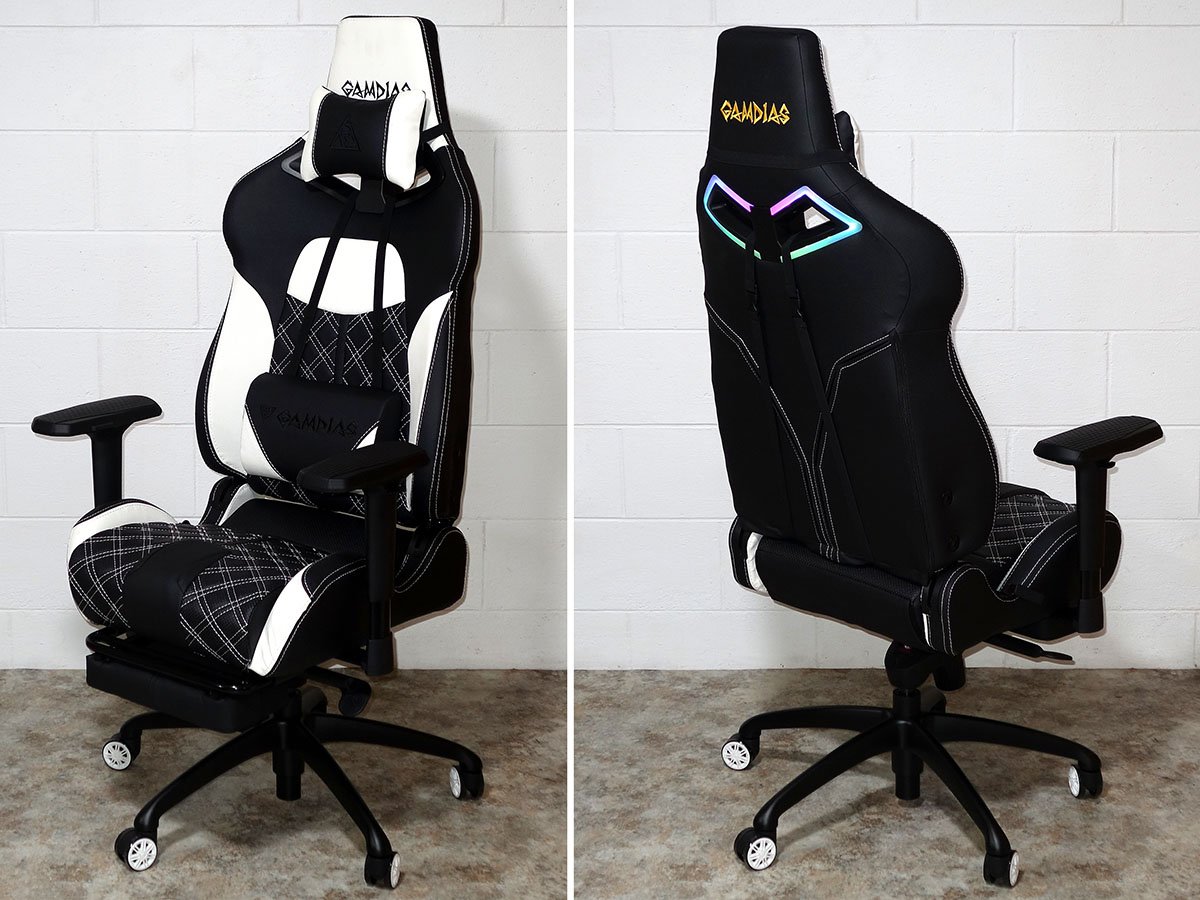Gamdias Achilles P1 RGB Gaming Chair, Hands On
You’ve filled your case with RGB lighting and synced everything together for a display that could put Las Vegas to shame, so what’s next? Why not try to match the chair? Gamdias is first to the market with a solution for that, erm, problem, and it's named Achilles. Currently available in both “L” (lattice pattern) and “S” (smooth) and four color options (black with white, red, blue, or black accents), we received the Achilles P1 L with the white accents.
| Back Height (to seat top) | ~36" |
| Seat Width between bolsters | ~16.5" (15.4" pad) |
| Seat Depth To Back | ~18.5" |
| Armrest Spacing | ~17.3 to 19.3" |
| Armrest Height | ~5.6 to 8.4" |
| Seat Height (front) | ~21.0 to 24.8" |
| Seat Height (rear) | ~19.0 to 22.8" |
| Backrest Angle | ~90° to 150° |
| Seat Angle Adjustment | ~11° (~9° to 22°) |
| Construction | Steel frame, aluminum base |
| Upholstery | Sythetic Leather (Perforated in Seat) |
| Weight | ~62lbs |
The Achilles P1 L in a huge 35x27x15” box with 11 pounds of packaging for a gross weight of 73 pounds.
Included are the back, seat base with attached arms, seat mechanism, lumbar and headrest pillows, wheels, hardware, USB cable, and a one-piece cast aluminum chair base rated at a hefty 1500kg capacity.
Instead of a seat pan, the Achilles P1 uses a full tubular metal frame to support a thick seat pad, arms, and backrest. Screws for attaching the tilt and lift mechanism are already screwed in, and must be removed to complete the assembly. Rated by a seat pad width of around 15.4”, curvature of the side bolsters provides approximately 1.1” additional butt room.
The seat mechanism includes separate levers for tilt lock and height adjustment. The tilt range is around 11° by our rough measurements.
The end of a USB cable protrudes from the bottom of the seat back, so that it can be plugged into a PC or notebook to set a lighting program. LED settings are retained on internal storage, allowing the same settings to function from an alternative power source (such as a portable power bank). The attachment method is also revealed in the below photo, as the brackets that secure the back to the base are to be pushed up through slits in the side bolster upholstery, and secured with exposed bolts.
The Achilles hardware kit includes large shoulder bolts for attaching the back, and a T-handle hex key to turn these. The P1 version adds a set of smaller socket head screws to be used as stops for the extendable leg rest, and a smaller hex key to secure those.
Get Tom's Hardware's best news and in-depth reviews, straight to your inbox.

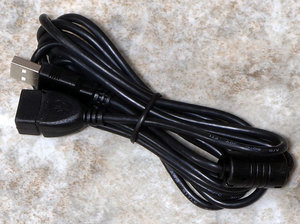
While factory photos showed a coiled USB extension cable, we received a 2m (78”) straight cable.
Functionality
The seat base is a little shorter in length than previously tested chairs, and the extra-thick lumbar pad pushes users even closer to that forward edge. Height adjustment is a little on the tall side, ranging from around 21” to 24.8” at the upper apex of the seat base. The padded steel side bolsters are about ¾” from our hips, which could be uncomfortable to users who themselves have an, ahem, “wide base”.
A rocker switch at the inside edge of each firmly-padded armrest unlocks it to slide forward and back, inward and out, and to swivel. The swivel lock is a marked improvement over the unlocked swivel function of chairs like Corsair’s T1 Race, which often required adjustment after being bumped.
The recline lever is found at its pivot, just forward of the Achilles P1’s back. It’s notchier than most, feeling as though its teeth have rough edges, but it engages very firmly. Also seen below is the side tab for unlocking arm height adjustment.
Upholstery on the bottom pad is perforated to improve breathability of the synthetic material. The back upholstery doesn’t have this treatment.
The back reclines “150°” aka 60° from vertical. Since it’s attached to a pivot base, an additional 11° of recline is available by pivoting the front of the seat upward. The leg rest slides out, and flipping the pad to its upright position gives the chair around 12.8” of extension.
Control software for the entire Gamdias RGB line (including mice, keyboards, and headsets) can be downloaded from its site. The Achilles P1 L is factory set to RGB Wave mode, and “static” is the only mode where custom color settings worked properly. “Breathing” mode allows one to choose colors, but the breathing pattern still cycles through the basic pallet.
Software installation leaves the keyboard shortcut box unchecked by default, which is sad, because the shortcut in “Programs” failed to launch the first time. We had to right click that to find the original shortcut, and open it the first time as administrator. Consecutive program launches were unencumbered.
Continuous testing caused the software to lock up with random LED blinking stored on the chair’s firmware, but closing and reopening the application fixed that.
Butt How Did It Feel?
Let’s start with the Corsair T1 Race as a baseline, with its deep and dished bottom pad pushing the front of our legs up slightly, which wasn’t painful but did take a while to get accustomed to. The Achilles P1 L’s shorter base and flatter seat pad combine with a thick lumbar support that pushes the sitter closer to the edge to allow our legs to droop a little more at any given bottom tilt angle.
The wheels and castors lack ball bearings but instead feel bushed, rolling and pivoting far more smoothly than those of cheap chairs. The ball-bearing castors and wheels of the T1 Race chair could have beaten this, except that those castors were looser and flopped around too much to make directional changes easy.
The Achilles P1 leg rest supports my calves between midpoint and ankle with the chair’s back fully reclined. It’s impractically short when used in the upright position, if that matters.
The only ergonomic weaknesses are that the rigid seat frame doesn’t have any give for the hard foam padding and that the lumbar pad is a little too thick. Both problems should be minimized after an extended break-in period, and are likewise eased in warmer climates. The lumbar pad is also too narrow compared to the back, making it too easy to knock off-center. We should further remind that the padded-steel side bolsters are likely to be a bit too narrow for padunka dunks thick thighs.
But what about the price? You’re getting a lot of chair with a frame this sturdy, limited primarily by its Class 4 lift to 440lbs. On the other hand, the steel-based Achilles E1 L is nearly $200 cheaper at $269, lacking only the P1’s aluminum base, leg rest, and seat tilt mechanism. We'd have none of that: we wanna rock.
-
JQB45 I'd like to see a plus size version with a larger seat pad width and wider width between arm rests.Reply
Seat Width between bolsters ~16.5" (15.4" pad)
That sounds like economy airline seat type width. While this restriction on an aircraft makes economical sense. It makes no sense on a premium product you should want to sit on for hours per day. -
Crashman Reply
But the armrests are set apart wider than economy and you get to use both of them :D20431725 said:I'd like to see a plus size version with a larger seat pad width and wider width between arm rests.
Seat Width between bolsters ~16.5" (15.4" pad)
That sounds like economy airline seat type width. While this restriction on an aircraft makes economical sense. It makes no sense on a premium product you should want to sit on for hours per day.
